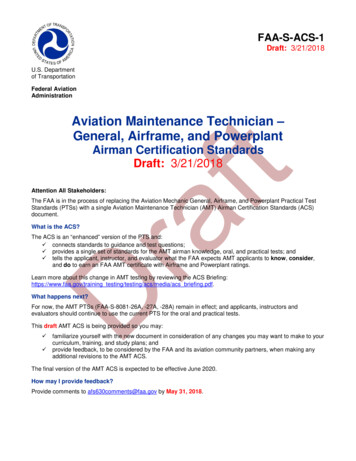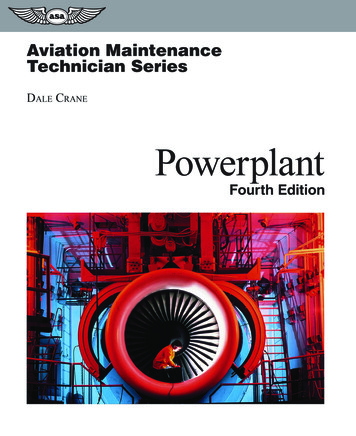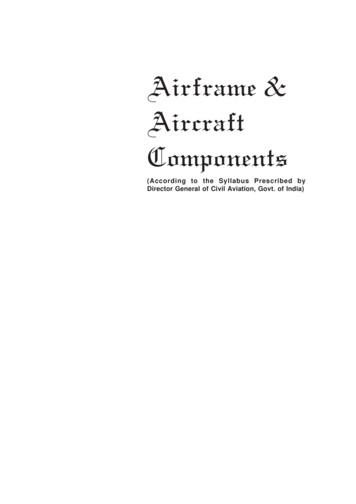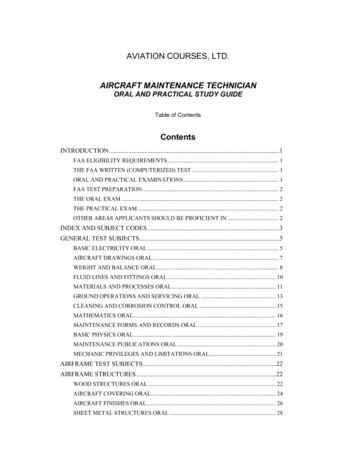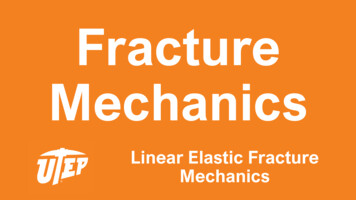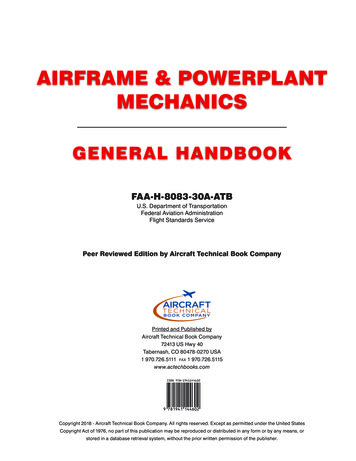
Transcription
AIRFRAME & POWERPLANTMECHANICSGENERAL HANDBOOKFAA-H-8083-30A-ATBU.S. Department of TransportationFederal Aviation AdministrationFlight Standards ServicePeer Reviewed Edition by Aircraft Technical Book CompanyPrinted and Published byAircraft Technical Book Company72413 US Hwy 40Tabernash, CO 80478-0270 USA1 970.726.5111 fax 1 970.726.5115www.actechbooks.comCopyright 2018 - Aircraft Technical Book Company. All rights reserved. Except as permitted under the United StatesCopyright Act of 1976, no part of this publication may be reproduced or distributed in any form or by any means, orstored in a database retrieval system, without the prior written permission of the publisher.
COMPLETE MATCHING AND INTEGRATED STUDY SETFOR THE A&P STUDENTAvailable in Print Format or as Bookmarked PDF eBooks at -ATBPEER REVIEWED EDITIONFOR USE WITH FAA-H-8083-30A-ATBFor Use With FAA-H-8083-32-ATB Powerplant HandbookGENERAL WORKBOOKFAA-H-8083-32-ATB2nd EditionInstrumentsCommunication &NavigationHydraulic/PneumaticLanding GearFuel SystemsIce & Rain ProtectionEnvironmentalFire ProtectionAircraft StructuresAssembly & RiggingFabric CoveringMetal RepairWeldingAircraft WoodCompositesPaint & FinishElectrical Systems72413 US Hwy 40Tabernash, CO 80478-0270 USA1 970.726.5111www.actechbooks.com72413 US Hwy 40Tabernash, CO 80478-0270 USA1 970.726.5111www.actechbooks.comAirframe & Powerplant Mechanics - Powerplant WorkbookAirframe & Powerplant Mechanics - General HandbookAirframe & PowerplantMechanicsFAA-H-8083-31-ATBAirframe & Powerplant Mechanics - Powerplant Handbook72413 US Hwy 40Tabernash, CO 80478-0270 USA1 970.726.5111www.actechbooks.com2nd EditionAirframe & Powerplant Mechanics - Airframe Handbook, Volume 2GENERAL HANDBOOKAirframe & Powerplant Mechanics - Airframe Handbook, Volume 1GENERAL - AIRFRAME - POWERPLANTATB editions correct nearly 300 errors found in original editions.Airframe & Powerplant Mechanics - General HandbookFAA-H-8083 ATB TEXTBOOKSAirframe & PowerplantMechanicsFor Use With FAA-H-8083-31-ATB Airframe HandbookFor Use With FAA-H-8083-31-ATB Airframe HandbookFOR USE WITH FAA-H-8083-30A-ATB2019 - GENERAL TEST GUIDEFAA-H-8083 ATB WORKBOOKSGENERAL - AIRFRAME - POWERPLANTWritten to match and referenced to the 8083 textbookswith Exercises, Chapter Exams, and more.ADVISORY CIRCULARAC43.13 1B/2BAcceptable Methods,Techniques, and Practices ofAircraft Inspection and RepairFor Use With FAA-H-8083-32-ATB Powerplant HandbookAirframe & PowerplantMechanics72413 US Hwy 40Tabernash, CO 80478-0270 USA1 970.726.5111www.actechbooks.com2018Airframe & Powerplant Mechanics - Powerplant Test Guide72413 US Hwy 40Tabernash, CO 80478-0270 USA1 970.726.5111www.actechbooks.comAirframe & Powerplant Mechanics - Airframe Test Guide72413 US Hwy 40Tabernash, CO 80478-0270 USA1 970.726.5111www.actechbooks.comAirframe & Powerplant Mechanics - General HandbookAirframe & Powerplant Mechanics - Airframe Workbook72413 US Hwy 40Tabernash, CO 80478-0270 USA1 970.726.5111www.actechbooks.com2018INCLUDES FREE ONLINE EXAMFAA-H-8083 ATB TEST GUIDESGENERAL - AIRFRAME - POWERPLANTWritten to match and referenced to the 8083 textbookswith Written, Oral And Practical questions.Department of TransportationFederal Aviation AdministrationFlight Standard ServiceRegulatory Support DivisionAFS-600AC43.13 1B/2BAcceptable MethodsA&P LOGBOOKRecord your shop and work experience.FAA and EASA compliant.Aircraft Inspection and Repair1.970.726.5111www.actechbooks.comTabernash, Colorado USAii
PrefaceThe Aviation Maintenance Technician Handbook–General (FAA-H-8083-30A) was developed as one of a series of threehandbooks for persons preparing for mechanic certification with airframe or powerplant ratings, or both. It is intended that thishandbook will provide basic information on principles, fundamentals, and technical procedures in the subject matter areascommon to both the airframe and powerplant ratings. Emphasis in this volume is on theory and methods of application.The handbook is designed to aid students enrolled in a formal course of instruction preparing for FAA certification as amaintenance technician as well as for current technicians who wish to improve their knowledge. This volume containsinformation on mathematics, aircraft drawings, weight and balance, aircraft materials, processes and tools, physics, electricity,inspection, ground operations, and FAA regulations governing the certification and work of maintenance technicians. New tothis volume is a section addressing how successful aviation maintenance technicians incorporate knowledge and awarenessof ethics, professionalism and human factors in the field.Because there are so many different types of airframes and powerplants in use today, it is reasonable to expect that differencesexist in the components and systems of each. To avoid undue repetition, the practice of using representative systems andunits is implemented throughout the handbook. Subject matter treatment is from a generalized point of view, and shouldbe supplemented by reference to manufacturers’ manuals or other textbooks if more detail is desired. This handbook is notintended to replace, substitute for, or supersede official regulations or the manufacturers’ instructions.The companion handbooks to Aviation Maintenance Technician Handbook–General (FAA-H-8083-30A) are the AviationMaintenance Technician Handbook–Airframe (FAA-H-8083-31, as amended), and the Aviation Maintenance TechnicianHandbook–Powerplant (FAA-H-8083-32, as amended).This handbook may be purchased in Print and eBook format from Aircraft Technical Book Company by Phone at:1 (970) 726-5111 or online at www.actechbooks.com/products/act180/This ATB edition has been thoroughly reviewed for errors and corrected by a team of A&P instructors from the schools listedbelow and re-released as FAA-H-8083-30A-ATB. The revision log on the following pages details each correction made. Yourcomments regarding this book including additional notifications of errors which have not yet been seen by our review team arewelcome by calling 1 (970) 726-5111 or by writing an email to us at: agold@actechbooks.comPeer Review TeamBernard Adams; Pittsburgh Institute of AeronauticsJon Byrd; Georgia NW Technical CollegePaul Chlapecka; San Diego Miramar CollegeFred Dyen; Blue Ridge Community CollegeTim Guerrero; Spartan CollegeDusty Kerbel; Spartan CollegeAndrew Langer; Spartan CollegeMichael Potter; Clover Park Technical CollegeGene Sprang; Columbus State Community CollegeTom Stose; Robert C Byrd Aerospace Centeriii
Revision Log1-6 Replaced existing image with standard fire trianglefor clarity.7-35 Paragraph added explaining manufacturer’s shelf life ofpacked seals.1-6 Added and clarified Class D fires as a standardclassification.7-41 A Jo-Bolt is a blind fastener, not a rivet.1-17 Stated that a fast EGT rise is an indicator of a hot start.1-18 Modified drawing for improved clarity.1-26 Added Jet-A to fuel color chart and specified that grade100/130 is green.2-5 DMEs, DMRs, etc., are decribed in part 183, not 21.2-14 Included DAMIs under representative types.7-42 Specified that hardware substitutions are allowed onlywith manufacturer’s approval.7-44 Removed rocker box covers as an example for the useof self locking nuts.7-45/46 "Fiber" locknut inserts are obsolete and have beenreplaced with "Nylon" inserts. (14 instances)7-46 Spring nuts are commonly called Tinnerman nuts.3-4 Added missing dimension lines to Figure 3-2.7-46 Elastic stop nuts have limited time use and some shopsrequire discarding after each use.3-8 Specified that gear speed is measured in rpm.7-51 Explanation added on drag torque.3-10 Figure 3-7; Labeled pinion driving gear and spurdriven gear.7-52 Added that washers may be placed on the nut end of abolt to realign the cotter pin with the hole.3-21 Corrected erroneous formula for circumference.7-52 Stated need of a bucking bar when setting solid rivets.4-17 Added word "Schematics" as alternative term to"Wiring Diagrams"7-54 AN470 rivets are typical for interior structures;not MS20430 or MS20442.4-21 Figure 4-24. 5th line corrected to Break (short) type line.7-69 Only older aircraft (35 years ) used rivnuts to attachde-icer boots. Modern aircraft bond them on.4-25 Inserted wiring diagram from computer testingsupplement with explanation as an example ofa nomogram.5-8 A screw is not a "simple machine". It is an application ofan inclined plane.5-12 Figure 5-13; Arrows and labels added to showgear direction.5-13 Rewrote incorrect paragraph regarding chisels.5-14 "Something" called stress clarified to "forces" calledstress; plus other grammar corrections.5-17 Corrected erroneous equation in left column.5-19 Clarified the sun is a source of radiant energy; not a formof energy in itself.5-21 Most forced air engine cooling comes from the forwardmovement of the aircraft; not the propeller.5-23 Numerous typos corrected.5-30 Corrected erroneous output value in Figure 5-45.7-75 Left hand turnbuckle barrel ends are identified with agroove. Knurling hasn’t been used for 35 years.7-78 Specified that clip locks are not reusable.8-14 Figure 8-22; Clarified aluminum alloy described in Figure.8-16 Added warning about steam cleaning aluminum parts.9-5 Deleted reference to 35º AC flared fittings which arenow obsolete.9-7 Deleted instruction to anneal metal tubing prior to flaringwhich is only done in the factory.9-10 Figure 9-16; Added missing fluid line identifiers andcorrected label designation for rocket catalyst.9-11 Figure 9-19; Filled in missing AN fitting identifications.9-12 Figure 9-20; Numerous errors and omissions in chart.Replaced with correct data from AC43.13-1B.9-12/13 Flareless fittings are colored green; not blue.5-32 Fixed erroneous value for speed of sound.9-16 Deleted incorrect paragraph regarding identifying faultson the flare of a flareless fitting.5-36 The effect of humidity, (not just fog), on engineperformance is noticeable.9-16 Specified "bullet" method is only practical on soft, thinwalled tubing.5-46 Figure 5-72; The rear moveable surface on the rudder iscalled an anti-servo tab, not an anti-balance tab.9-20 Corrected caption on Figure 9-35 misstating it to be aflexible hose.6-21 Figure 6-34; Corrected erroneous arm values to conformwith text and math.9-22 Figure 9-39; The assembly shown is a low pressurehose, not medium.7-5 Firewalls added as a common application forstainless steel.11-2/3 Replaced term "common" screwdriver as "flatblade" screwdriver.v
Revision Log11-5 Removed statement: "Allen wrenches are seldom used."11-8 Added that torque wrenches must be calibrated.11-8 Stated impact wrenches are rarely used on aircraft.11-12 Deleted instruction to "tap file on a bench to clean".Use file card. Airplanes do not have benches.11-19 Corrected erroneous decimal equivalent."1/8" .125", not .0125"11-21 Added decimal equivalents to fractions on ruler.11-23 Figures 11-35; Replaced poor quality pictures ofoutside micrometers.11-25 Figure 11-39; Filled in missing labels depicting vernierand barrel scales.11-25 To view all scales, the thimble is turned;not the micrometer.12-2 Aircraft technicians should know about plasma.12-25 Corrected 4 tolerance specifications in Figure 12-49.12-38 Values expressed as 200 mA revised to .2 ampsfor consistency.12-110 1st paragraph; "emitter and collector" corrected to"emitter and base".12-111 Figure 12-227; Corrected flow direction on commoncollector schematic.12-116 Figure 12-237; Band-pass filter corrected toBand‑stop filter.12-161 Equation for Alternator Frequency corrected.12-138 Corrected appropriate sand paper type.14-12/13 Inserted missing headers clarifying discussion of MEDA,SHEL, and Swiss models.vi
Table of ContentsPreface.ivRevision Log.vTable of Contents.viiAcknowledgments. xxiChapter 1Safety, Ground Operations, and Servicing. 1-1Shop Safety.1-2Electrical Safety.1-2Physiological Safety.1-2Fire Safety.1-2Safety Around Compressed Gases.1-2Safety Around Hazardous Materials.1-3Safety Around Machine Tools.1-3Flight Line Safety.1-4Hearing Protection.1-4Foreign Object Damage (FOD).1-5Safety Around Airplanes.1-5Safety Around Helicopters.1-5Fire Safety.1-5Fire Protection.1-5Requirements for Fire to Occur.1-5Classification of Fires.1-6Types and Operation of Shop and Flight Line FireExtinguishers.1-6Inspection of Fire Extinguishers.1-8Identifying Fire Extinguishers.1-8Using Fire Extinguishers.1-9Tie-Down Procedures.1-9Preparation of Aircraft.1-9Tie-Down Procedures for Land Planes.1-10Securing Light Aircraft.1-10Securing Heavy Aircraft.1-11Tie-Down Procedures for Seaplanes.1-11Tie-Down Procedures for Ski Planes.1-11Tie-Down Procedures for Helicopters.1-11Procedures for Securing Weight-Shift-Control.1-12Procedures for Securing Powered Parachutes.1-12Ground Movement of AircrafT.1-13Engine Starting and Operation.1-13Reciprocating Engines.1-13Hand Cranking Engines.1-14Extinguishing Engine Fires.1-15Turboprop Engines.1-15Turboprop Starting Procedures.1-15Turbofan Engines.1-16Starting a Turbofan Engine.1-17Auxiliary Power Units (APUs).1-17Unsatisfactory Turbine Engine Starts.1-17Hot Start.1-17False or Hung Start.1-17Engine Fails to Start.1-19Towing of Aircraft.1-19Taxiing Aircraft.1-20Taxi Signals.1-21Servicing Aircraft.1-22Servicing Aircraft Air/Nitrogen Oil and Fluids.1-22Ground Support Equipment.1-24Electric Ground Power Units.1-24Hydraulic Ground Power Units.1-25Ground Support Air Units.1-25Ground Air Heating and Air Conditioning.1-25Oxygen Servicing Equipment.1-25Oxygen Hazards.1-26Fuel Servicing of Aircraft.1-26Types of Fuel and Identification.1-26Contamination Control.1-26Fueling Hazards.1-27Fueling Procedures.1-27Defueling.1-29Chapter 2Regulations, Maintenance Forms, Records, andPublications. 2-1Overview — Title 14 of the Code of FederalRegulations (14CFR).2-1Title 14 CFR Part 3—General Requirements.2-4Maintenance-Related Regulations.2-514 CFR Part 1—Definitions and Abbreviations.2-514 CFR Part 21—Certification Procedures forProducts and Parts.2-514 CFR Part 23—Airworthiness Standards:Normal, Utility, Acrobatic, and CommuterCategory Airplanes.2-814 CFR Part 25—Airworthiness Standards:Transport Category Airplanes.2-814 CFR Part 27—Airworthiness Standards:Normal Category Rotorcraft.2-814 CFR Part 29—Airworthiness Standards:vii
Transport Category Rotorcraft.2-814 CFR Part 33—Airworthiness Standards:Aircraft Engines.2-814 CFR Part 35—Airworthiness Standards:Propellers.2-814 CFR Part 39—Airworthiness Directives.2-1014 CFR Part 43—Maintenance, PreventiveMaintenance, Rebuilding, and Alteration.2-1014 CFR Part 45—Identification and RegistrationMarking.2-1014 CFR Part 47—Aircraft Registration.2-1014 CFR Part 65—Certification: Airmen OtherThan Flight Crewmembers.2-1014 CFR Part 91—General Operating andFlight Rules.2-1114 CFR Part 119—Certification:Air Carriers and Commercial Operators.2-1114 CFR Part 121—Operating Requirements:Domestic, Flag, and Supplemental Operations.2-1214 CFR Part 125—Certification and Operations:Airplanes Having a Seating Capacity of 20 or MorePassengers or a Maximum Payload Capacity of 6,000Pounds or More; and Rules Governing Persons onBoard Such Aircraft.2-1314 CFR Part 135—Operating Requirements:Commuter and On-Demand Operations and RulesGoverning Persons on Board Such Aircraft.2-1314 CFR Part 145—Repair Stations.2-1414 CFR Part 147—Aviation MaintenanceTechnician Schools.2-1414 CFR Part 183—Representatives of theAdministrator.2-14Explanation of Primary Regulations (Parts 43 and 91).2-1514 CFR Part 43—Maintenance, PreventativeMaintenance Rebuilding, and Alteration.2-15Appendix A—Major Alterations, Major Repairs, andPreventive Maintenance.2-20Appendix B—Recording of Major Repairs and MajorAlterations.2-21Appendix C—(Reserved).2-21Appendix D—Scope and Detail of Items To BeIncluded in Annual and 100-Hour Inspections.2-21Appendix E—Altimeter System Test andInspection.2-21Appendix F—ATC Transponder Tests andInspections.2-2114 CFR Part 91—General Operating andFlight Rules.2-21Subpart A—General.2-21Subpart E—Maintenance, Preventive Maintenance,and Alterations.2-22Civil Air Regulations (CAR).2-24CAR 3—Airplane Airworthiness—Normal, Utility,Aerobatic, and Restricted Purpose Categories.2-24CAR 4a—Airplane Airworthiness.2-26viiiSuspected Unapproved Parts (SUP).2-26Other FAA Documents.2-26Advisory Circulars (AC).2-26The AC Numbering System.2-26Types of Airworthiness Directives (AD).2-27AD Content.2-27AD Number.2-27Applicability and Compliance.2-27Alternative Method of Compliance.2-30Special Airworthiness Information Bulletin (SAIB).2-30Aircraft Specifications.2-30Cessna; 182T; Locked Rudder Trim Wheel;A4A 2721.2-30Supplemental Type Certificates (STC).2-30Type Certificate Data Sheets (TCDS).2-33FAA Handbooks and Manuals.2-33Non-FAA Documents.2-33Air Transport Association A4A iSPec 2200.2-33Manufacturers’ Published Data.2-33Airworthiness Limitations.2-37Service Bulletins (SB).2-38Structural Repair Manual (SRM).2-38Forms.2-39Airworthiness Certificates.2-39Aircraft Registration.2-39Radio Station License.2-39FAA Form 337—Major Repair and Alteration.2-40Records.2-41Making Maintenance Record Entries.2-41Electronic Records.2-44Light Sport Aircraft (LSA).2-45Maintenance.2-45Aircraft Maintenance Manual (AMM).2-46Line Maintenance, Repairs, and Alterations.2-46Major Repairs and Alterations.2-46Chapter 3Mathematics in Aviation Maintenance. 3-1Introduction.3-1Whole Numbers.3-2Addition of Whole Numbers.3-2Subtraction of Whole Numbers.3-2Division of Whole Numbers.3-2Fractions.3-2Finding the Least Common Denominator.3-3Addition of Fractions.3-3Subtraction of Fractions.3-3Multiplication of Fractions.3-3Division of Fractions.3-4Reducing Fractions.3-4Mixed Numbers.3-4Addition of Mixed Numbers.3-4Subtraction of Mixed Numbers.3-4The Decimal Number System.3-5Origin and Definition.3-5
Addition of Decimal Numbers.3-5Subtraction of Decimal Numbers.3-6Multiplication of Decimal Numbers.3-6Division of Decimal Numbers.3-6Rounding Off Decimal Numbers.3-7Converting Decimal Numbers to Fractions.3-7Converting Fractions to Decimals.3-8Decimal Equivalent Chart.3-8Ratio.3-8Aviation Applications.3-8Proportion.3-10Extremes and Means.3-10Solving Proportions.3-10Percentage.3-10Expressing a Decimal Number as a Percentage.3-10Expressing a Percentage as a Decimal Number.3-11Expressing a Fraction as a Percentage.3-11Finding a Percentage of a Given Number.3-11Finding What Percentage One Number is of Another.3-11Finding a Number When a Percentage of it is Known.3-11Positive and Negative Numbers.3-12(Signed Numbers).3-12Addition of Positive and Negative Numbers.3-12Subtraction of Positive and Negative Numbers.3-12Multiplication of Positive and Negative Numbers.3-12Powers.3-12Special Powers.3-12Squared.3-12Cubed.3-12Power of Zero.3-12Law of Exponents.3-13Powers of Ten.3-13Roots.3-13Square Roots.3-13Cube Roots.3-13Fractional Powers.3-16Functions of Numbers Chart.3-16Scientific Notation.3-16Converting Numbers from Standard Notation toScientific Notation.3-16Converting Numbers from Scientific Notation toStandard Notation.3-16Addition, Subtraction, Multiplication, andDivision of Scientific Numbers.3-17Algebra.3-17Equations.3-17Algebraic Rules.3-17Solving for a Variable.3-17Use of Parentheses.3-18Order of Operation.3-18Order of Operation for Algebraic Equations.3-18Computing Area of Two-Dimensional 3-21Units of Area.3-22Computing Volume of Three-Dimensional Solids.3-22Rectangular 25Units of Volume.3-25Computing Surface Area of Three-Dimensional Solids.3-25Rectangular 25Trigonometric Functions.3-26Right Triangle, Sides, and Angles.3-26Sine, Cosine, and Tangent.3-26Calculator Method:.
Mechanics FAA-H-8083-30A-ATB PEER REVIEWED EDITION Airframe & Powerplant Mechanics - General Handbook GENERAL HANDBOOK 72413 US Hwy 40 Tabernash, CO 80478-0270 USA 1 970.726.5111 www.actechbooks.com Airframe & Powerplant Mechanics - Airframe Handbook, Volume 1 Aircraft

